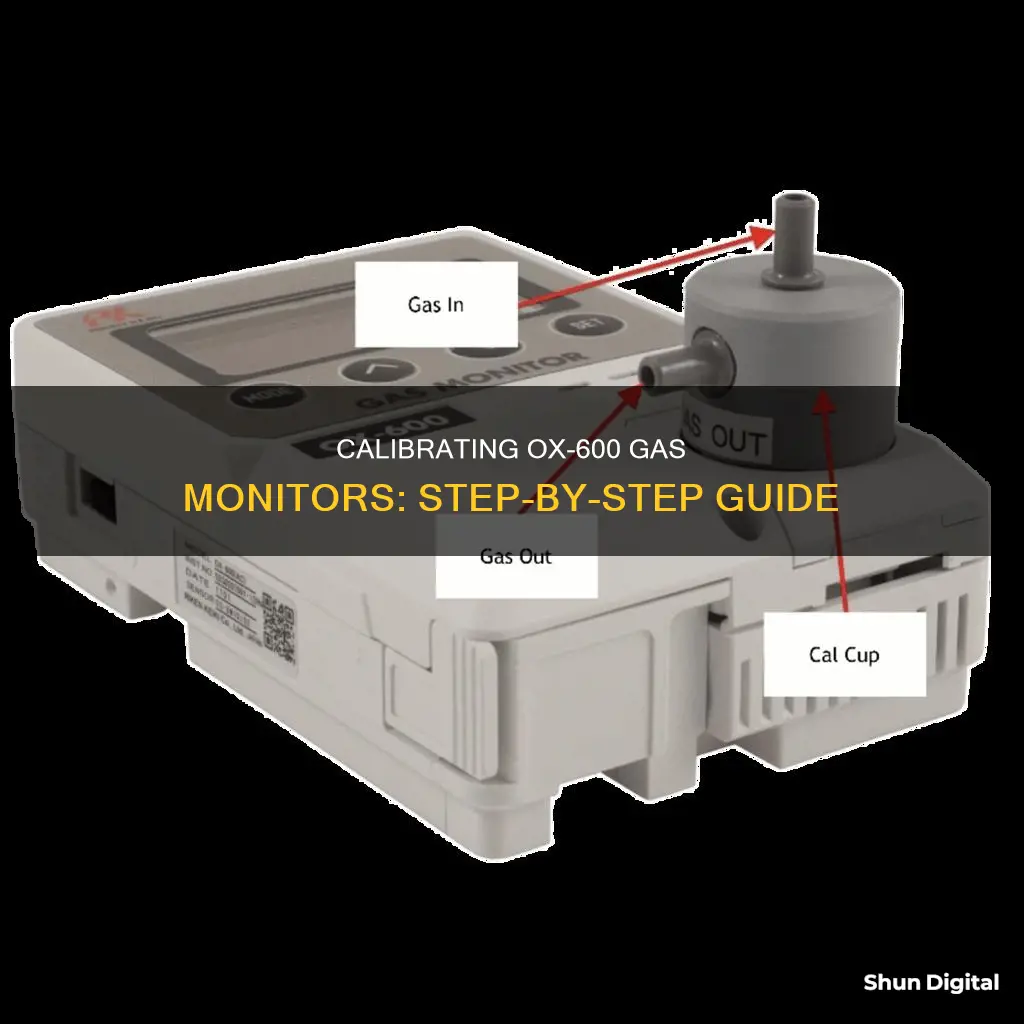
The Riken Keiki OX-600 is an indoor stand-alone oxygen (O2) depletion and enrichment monitor. It is a low-cost solution for facilities such as laboratories and hospitals that require oxygen monitoring. Calibration is essential to ensure the accuracy of gas detectors like the OX-600, and it is recommended to calibrate the OX-600 once every 30 days. Calibration kits are available for purchase and typically include the necessary components for the process. The calibration process involves following specific steps and guidelines to ensure the OX-600 monitor functions accurately and reliably.
| Characteristics | Values |
|---|---|
| Calibration Kit | Fixed for OX-600, 100% N2, reg with gauge & knob, cal cup, case & tubing |
| Calibration Frequency | Once every 30 days |
| Calibration Process | 1. Turn on the monitor in a clean air environment. |
| 2. Apply a test gas cylinder to the sensors for approximately 20 seconds. | |
| 3. Ensure the alarm goes off with an audible buzzer or flashing LED lights. | |
| 4. If the readings on the meter match the contents of the cylinder, the monitor is calibrated and working properly. | |
| 5. If the readings do not match, reconfigure the sensors so that they align with the contents of the test gas cylinder. | |
| Display | Tri-color visual alarm display |
| Alarm | 2 preset alarms; Green=Normal, Yellow=Alarm 1, Red=Alarm 2 |
| Power Options | 115 VAC, 24 VDC, or 2 AA alkaline |
What You'll Learn

The importance of calibration
Calibration is a critical aspect of maintaining gas monitors such as the OX-600. Calibration ensures that the device can accurately detect gas levels, providing reliable protection against hazardous gases. Here are several reasons why calibration is essential:
Accuracy and Reliability
Calibration establishes a reference point for the gas detector by exposing it to a known concentration of calibration gas. This reference point serves as the basis for future readings, allowing the device to accurately measure and respond to changes in gas levels. Without regular calibration, sensors can drift over time, leading to unreliable readings.
Worker Safety
The primary goal of calibration is to ensure the safety of workers in hazardous environments. Proper calibration provides accurate gas concentration readings, helping to prevent worker illness, injury, or even death. Calibrated instruments can detect toxic gases, oxygen deficiency, or enrichment, and combustible gases, warning workers of potential dangers before they reach dangerous levels.
Compliance and Standards
Calibration is necessary to comply with safety standards and regulations. The Occupational Safety and Health Administration (OSHA) recommends developing standard procedures for calibration and documentation to ensure proper maintenance of gas detectors. Failure to comply with these standards can result in citations and penalties.
Sensor Drift Correction
Calibration helps correct sensor drift, which is the natural tendency of a sensor's performance to degrade over time as its components age. Sensor drift can lead to inaccurate readings, and regular calibration is the only way to verify and adjust the gas monitor's reference point.
Application Flexibility
Calibration ensures that gas monitors can be used in various environments and applications. By calibrating the device in similar working conditions, including temperature, pressure, and humidity, you can trust that the readings will be accurate regardless of the environment.
In conclusion, calibration of gas monitors like the OX-600 is of utmost importance to ensure accuracy, reliability, and, most importantly, worker safety. By following manufacturer recommendations and industry standards for calibration, you can be confident that your gas monitor will alert you to invisible hazards and protect you as expected.
Performance Test Monitoring: Key Metrics to Watch
You may want to see also

Calibration frequency
The manufacturer, RKI Instruments, offers an OX-600 Calibration Kit, which suggests that calibration is necessary for this device. While the frequency of calibration is not specified by the manufacturer, a third-party seller of the calibration kit recommends quarterly calibration.
OSHA (Occupational Safety and Health Administration) guidelines recommend calibrating multi-gas and single-gas detectors before each use, although this may not be practical for all teams. In such cases, OSHA suggests following the manufacturer's guidelines on calibration frequency.
It is important to perform calibration testing if the monitor has been dropped, damaged, or left unused for extended periods. Additionally, if the device has been exposed to high gas concentrations, extreme temperatures, or electrical shocks, it may only be partially operational and require calibration.
For single-gas monitors, it is recommended to calibrate at least once a month to maintain sensitivity. Multi-gas monitors have varied calibration processes depending on the quantity of gas to be monitored, so referring to the manufacturer's guidelines is essential.
In general, it is advisable to calibrate gas monitors at least monthly and perform a bump test before each day's use to ensure accurate performance and worker safety.
Easy Guide: Install Vivid Pixel on Your ASUS Monitor
You may want to see also

Manual vs automated calibration
Calibration is a critical aspect of maintaining gas monitors. While the procedure is not particularly challenging or time-consuming, it is often hard to find the time in busy schedules. However, neglecting routine maintenance can lead to exposure to dangerous hazards like toxic gases, oxygen deficiency, or combustible gases, which can have fatal consequences.
Manual Calibration
Manually calibrating an OX-600 gas monitor involves checking the owner's manual and following the outlined steps. This process should take no more than five minutes per monitor, making it a convenient option for calibrating a small number of devices. It is important to expose the sensors to the right gas during calibration to ensure accurate results. The environment, including temperature, pressure, and humidity, can also impact the calibration, so it is recommended to calibrate the gas monitor in conditions similar to the work environment.
Automated Calibration
For larger teams with numerous monitors, manual calibration may not be the most efficient option. In such cases, automated calibration equipment, such as monitor docking stations, can be used. This method allows for the simultaneous calibration of multiple devices, saving time and increasing efficiency. Automated calibration typically takes a few hours, so employees can leave their monitors in the docking station to calibrate overnight or during off-work hours without interrupting operations.
Calibration Kits
Calibration kits for the OX-600 are also available for purchase. These kits provide the necessary tools for fixed calibration, including 100% N2, a regulator with a gauge and knob, a calibration cup, a case, and tubing.
Calibration Frequency
The frequency of calibration depends on the specific type of gas monitor and usage patterns. The Occupational Safety and Health Administration (OSHA) recommends calibrating portable gas monitors before each use, especially if they have been dropped, damaged, or left unused for extended periods. Additionally, OSHA suggests checking equipment used in environments with high levels of concern daily or even hourly.
In general, single-gas monitors should be calibrated at least once a month, while multi-gas monitors should be calibrated based on the manufacturer's recommendations and the quantity of gas being monitored. Bump testing, a quick check to ensure the device responds to a gas concentration, should also be performed before each use.
The i7 Question: Is It Worthy For 1080p?
You may want to see also

Bump testing
The Riken Keiki OX-600 is an indoor stand-alone industrial oxygen (O2) depletion and enrichment monitor. It is a low-cost solution for use where oxygen monitoring is required. The OX-600 is capable of operating with three different power options: 115 VAC, 24 VDC, or alkaline batteries.
However, bump tests do not check for accuracy. To check for accuracy, you must calibrate the gas detector. Calibration and testing tell you how reliable and accurate your gas monitor is. Air monitor calibration and testing are done with a known, traceable concentration of hazardous gas to ensure that the monitor sensors are responding accurately and that the alarms function. Once calibrated, the instrument’s meters get reset to match the test gas, which ensures that all readings are accurate.
Both bump testing and calibration are necessary to verify gas monitor functionality before use. Bump testing verifies that your gas monitor will detect the target gas in a work environment. When bump testing, you don’t have to worry about zeroing the meters or comparing the readout to the contents of the test gas. Bump testing should take place on a daily basis before the device is used. If the first bump test fails, a full calibration of the device is required.
- Use a docking station: Docking stations are the easiest and most efficient way to bump test. They draw gas through a connected cylinder and then apply that gas to the detector that is docked. Docking stations can also charge, calibrate, and perform various other maintenance tasks. They are often connected to gas detection management software, which allows you to schedule bump tests to start automatically every day.
- Perform a manual bump test: If you don't have access to a docking station, you can perform a manual bump test using a gas bottle, a regulator, tubing, a calibration cup (if using a diffusion instrument), and a gas detector. Put the gas detector into bump test mode, then apply the gas. The gas detector will cycle through each individual sensor or do them all at once, depending on its settings. After the test is complete, the monitor will display the results, showing whether it passed or failed the bump test.
- Alternatively, you can manually apply gas: You can also perform a manual bump test by simply applying gas to the instrument while it is on the main gas reading screen. If each sensor shows readings in response to the gas and the detector goes into alarm, then that instrument is good to go.
Cutting Off: Removing Electronic Monitoring Bracelets Illegally
You may want to see also

Calibration kits and accessories
The OX-600 Calibration Kit is essential for calibrating your OX-600 gas monitor. This kit includes everything you need to perform accurate and reliable calibrations, ensuring your gas monitor maintains optimal performance and accuracy. Here are the key components and accessories included in the calibration kit:
- Calibration Cup: This cup is designed to hold the calibration gas during the calibration process. It ensures that the gas is contained and allows for precise measurements.
- Regulator and Gauge: The regulator controls the flow rate of the calibration gas, allowing you to set the desired flow rate for accurate calibration. The gauge provides a visual indication of the gas pressure and flow rate, helping you monitor the process.
- 100% N2 Cylinder: Nitrogen gas (N2) is used as the calibration gas in the OX-600 calibration kit. The cylinder contains pure nitrogen, which is crucial for simulating controlled conditions during calibration.
- Tubing: The calibration kit includes tubing to connect the different components. It ensures a secure and leak-free path for the calibration gas to flow from the cylinder to the calibration cup.
- Carrying Case: A sturdy and protective carrying case is provided to store and transport the calibration kit. This case keeps all the components organised and safe, making it convenient to carry out calibrations wherever needed.
In addition to the standard components mentioned above, the OX-600 calibration kit may also offer optional accessories, such as:
- Zero Emission Air Cylinder: This cylinder contains clean air and is used specifically for bump testing the OX-600 gas monitor. Bump testing is performed to ensure the gas monitor is functioning correctly and responding to the target gas.
- Calibration Adapter: The calibration adapter is used in conjunction with the calibration cup and tubing to establish a secure connection between the gas cylinder and the calibration setup.
Performance Monitoring Plan: Definition and Benefits
You may want to see also
Frequently asked questions
It is recommended to calibrate the OX-600 gas monitor once every 30 days.
Calibration can be done manually or through an automated system. Manual calibration involves reconfiguring the sensors of the alarm to match the contents of a test gas cylinder. Automated calibration can be done using a gas monitor docking station, which calibrates the monitor overnight or when it is not in use.
A bump test involves turning on the monitor in a clean air environment and applying a test gas cylinder to the sensors for approximately 20 seconds. Ensure that the alarm goes off with an audible buzzer or flashing LED lights. If the readings on the meter do not match the contents of the cylinder, a full calibration is required.
The calibration kit includes a cylinder of 34 liters of 20.9% O2 oxygen zero-grade air, a cylinder of 34 liters of 100% N2 nitrogen, a regulator, a calibration cap/adapter, and a plastic carry case.







